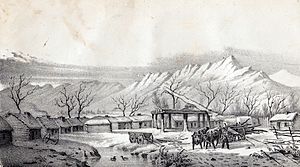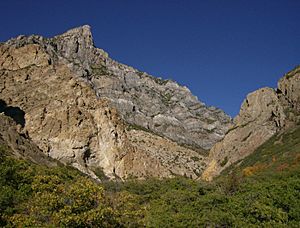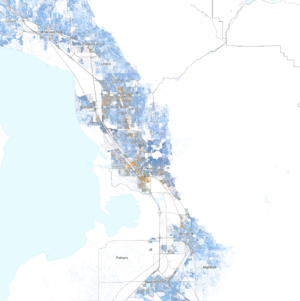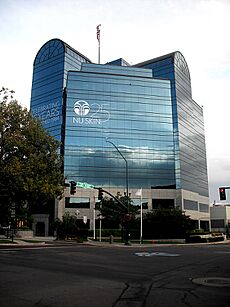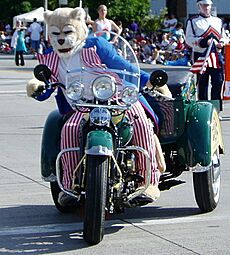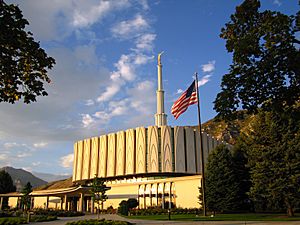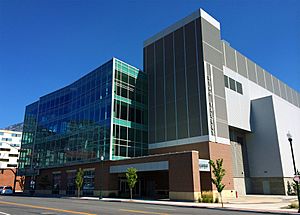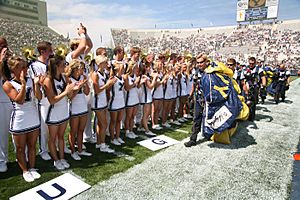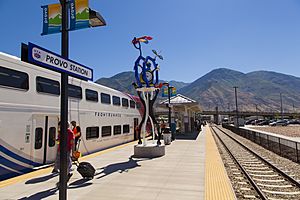Provo, Utah facts for kids
Quick facts for kids
Provo
Fort Utah
|
||
|---|---|---|
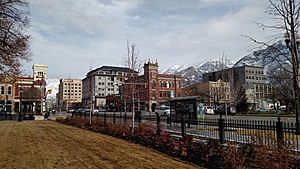
Downtown Provo in January 2016
|
||
|
||
| Motto(s):
"Welcome Home"
|
||
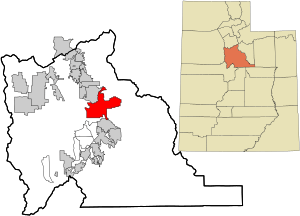
Location of Provo in Utah County, Utah
|
||
| Country | United States | |
| State | Utah | |
| County | Utah | |
| Founded | 1849 | |
| Incorporated | April 1850 | |
| Named for | Étienne Provost | |
| Government | ||
| • Type | Mayor–council | |
| Area | ||
| • City | 44.19 sq mi (114.44 km2) | |
| • Land | 41.69 sq mi (107.97 km2) | |
| • Water | 2.50 sq mi (6.47 km2) | |
| Elevation | 4,551 ft (1,387 m) | |
| Population
(2020)
|
||
| • City | 115,162 | |
| • Density | 2,762.34/sq mi (1,066.61/km2) | |
| • Urban | 588,609 (US: 75th) | |
| • Urban density | 3,653.5/sq mi (1,410.6/km2) | |
| • Metro | 697,141 (US: 86th) | |
| Time zone | UTC−7 (Mountain (MST)) | |
| • Summer (DST) | UTC−6 (MDT) | |
| ZIP Codes |
84601-84606
|
|
| Area codes | 385, 801 | |
| FIPS code | 49-62470 | |
| GNIS ID | 2411499 | |
Provo is a city in Utah County, Utah, in the United States. It is the main city of Utah County. Provo is about 43 miles (69 km) south of Salt Lake City. It is located between Orem to the north and Springville to the south.
In 2020, Provo had a population of 115,162 people. This makes it the fourth-largest city in Utah. Provo is also the main city in the larger Provo-Orem area. This area is Utah's second-largest metropolitan area, after Salt Lake City.
Provo is home to Brigham Young University (BYU). This is a private university run by the Church of Jesus Christ of Latter-day Saints (LDS Church). The city also has the LDS Church's largest Missionary Training Center (MTC). Provo is a growing center for technology companies. Many successful new businesses have started here. The city's Peaks Ice Arena was used for the 2002 Winter Olympics in Salt Lake City.
Contents
History of Provo
The area where Provo is now was first called Timpanogas. This name came from the Ute people. It might mean "rock river." The Timpanogos Native Americans lived here. They were a peaceful people because the Provo River provided lots of food. This area was also a special meeting place for the Ute and Shoshone tribes. They used it for worship.
In 1776, a Spanish explorer named Silvestre Vélez de Escalante visited the area. He was the first European to explore this region. He traded with the Timpanogos.
In 1847, Mormon pioneers arrived in the Salt Lake Valley. This was just north of Mount Timpanogos. At first, the Native Americans and Mormons were friendly. But soon, problems started over land and cattle. This led to conflicts, including the Battle Creek massacre.
In 1849, 33 Mormon families from Salt Lake City started a settlement called Fort Utah. In 1850, there was a conflict called the Provo War. After this, Fort Utah was renamed Provo. It was named after Étienne Provost, an early French-Canadian trapper who visited the area in 1825.
The first schoolhouse in Provo was built in 1850, inside Fort Utah. As more Latter-day Saints arrived, Provo grew quickly. It was soon called The Garden City because of its many fruit orchards and gardens. In 1872, a railroad reached Provo. The Provo Woolen Mills also opened that year. This was the first large factory in Provo. It employed about 150 people.
Geography and Nature
Provo is located on the eastern side of Utah Lake in Utah Valley. The city is about 4,549 feet (1,387 meters) above sea level. Most of Provo is land, but about 5.66% is water.
The Wasatch Range of mountains is just east of Provo. One famous mountain is Y Mountain, which stands over the city. There is a large white "Y" on the mountainside. It was built to honor Brigham Young University. Wild deer, and sometimes cougars or moose, can be seen in the mountains and even in the city. The mountains offer great opportunities for hiking, skiing, and other outdoor activities.
Provo's Climate
Provo has warm, dry summers and cold, snowy winters. The average yearly rainfall is about 17.23 inches (43.76 cm). Winters bring a lot of snow, averaging about 57.2 inches (145 cm) each year. Sometimes, temperatures can drop below 0°F (-18°C) in winter.
Springtime warms up quickly. Summers are hot and dry. The hottest temperature ever recorded in Provo was 108°F (42°C) on July 13, 2002. Fall brings cooler weather and a transition to winter.
People of Provo (Demographics)
| Historical population | |||
|---|---|---|---|
| Census | Pop. | %± | |
| 1860 | 2,030 | — | |
| 1870 | 2,384 | 17.4% | |
| 1880 | 3,432 | 44.0% | |
| 1890 | 5,159 | 50.3% | |
| 1900 | 6,185 | 19.9% | |
| 1910 | 8,925 | 44.3% | |
| 1920 | 10,303 | 15.4% | |
| 1930 | 14,766 | 43.3% | |
| 1940 | 18,071 | 22.4% | |
| 1950 | 28,937 | 60.1% | |
| 1960 | 36,047 | 24.6% | |
| 1970 | 53,131 | 47.4% | |
| 1980 | 74,108 | 39.5% | |
| 1990 | 86,835 | 17.2% | |
| 2000 | 105,166 | 21.1% | |
| 2010 | 112,488 | 7.0% | |
| 2020 | 115,162 | 2.4% | |
| U.S. Decennial Census | |||
In 2020, Provo had 115,162 people. About 70.9% of the people were White. About 18.6% of the population was Hispanic or Latino.
The median age in Provo was 23.3 years old. This is quite young, partly because of the large number of university students.
Religion in Provo
| Religion in Provo, Utah (2010) | ||||
|---|---|---|---|---|
| Religion | ||||
| LDS | 88.7% | |||
| Catholic | 1.3% | |||
| Protestant | 0.6% | |||
| Other | 0.3% | |||
| None | 9.1% | |||
Most people in Provo are Christian. In 2010, about 88.7% of the population were members of the Church of Jesus Christ of Latter-day Saints. Other religions, like Catholic and Protestant, make up smaller parts of the population. About 9.1% of people did not follow any religion.
Economy and Jobs
Provo has many restaurants and two main shopping centers: The Shops At Riverwoods and Provo Towne Centre. The downtown area also has many small shops and music places. Downtown Provo hosts "gallery strolls" every first Friday of the month, showing off local artists.
Several companies based in Provo are growing very fast. These include DieCuts With a View, VitalSmarts, and Connect Public Relations. Ryze Trampoline Parks, a global entertainment company, has its main office in Provo.
Novell, a big computer networking company, used to have its headquarters in Provo. Now, Micro Focus still has offices there. The Food & Care Coalition is a local group that helps homeless and low-income people in Provo.
Major Companies in Provo
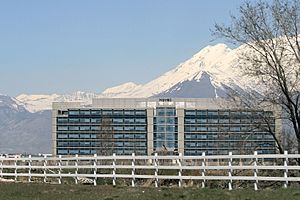
Many important companies have their headquarters or large offices in Provo:
- Action Target: Makes shooting ranges.
- Morinda Bioactives: Sells health and skin care products made from the noni fruit.
- North American Arms: Makes firearms.
- Nu Skin Enterprises: Sells skin care products.
- Qualtrics: A company that makes research software.
- Vivint: A company that provides home security systems.
Top Employers in Provo
The biggest employers in Provo include:
- Brigham Young University (5,000-6,999 employees)
- Utah Valley Regional Medical Center (3,000-3,999 employees)
- Vivint (3,000-3,999 employees)
- Qualtrics (1,000-1,999 employees)
- Nu Skin International (500-999 employees)
Arts and Culture
Yearly Events
Every July, Provo hosts America's Freedom Festival at Provo. This includes the Stadium of Fire at BYU's LaVell Edwards Stadium. This Independence Day celebration is very popular. It features concerts and fireworks.
Provo also has two big festivals in the fall. The Festival Latinoamericano is a family event that celebrates Hispanic culture with food, vendors, and performances. The city also hosts an annual LGBT Provo Pride Festival.
Places to Visit
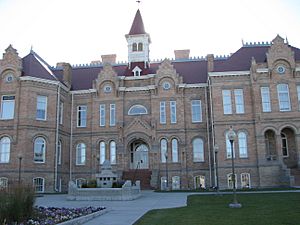
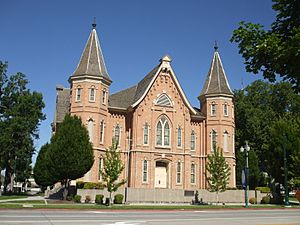
Covey Center for the Arts
The Covey Center for the Arts is a place for performances. It has plays, ballets, art shows, and music all year. The main hall can seat 670 people. There are also dance studios and art galleries.
LDS Church Missionary Training Center (MTC)
Provo is home to the largest MTC of the LDS Church. Each week, hundreds of missionaries come here for training before they go to serve in different countries. They learn languages and prepare for their missions. The MTC was built in the 1970s and has been expanded several times.
Provo City Library at Academy Square
The Provo City Library is a public library. It is located in the old Brigham Young Academy building, which was built in 1892. The building is a historic landmark. The library has over 277,000 items.
Provo Recreation Center
This center, built in 2013, offers many water activities and other recreation options.
Provo Utah Temple
The Provo Utah Temple is an LDS Church temple located near Rock Canyon. It has been a very busy temple. It closed in February 2024 and is being rebuilt. It will reopen in 2027 as the Provo Utah Rock Canyon Temple.
Provo City Center Temple
This is another LDS Church temple in Provo. It is located in the city center. It was built after a fire destroyed the historic Provo Tabernacle in 2010. The temple was finished and dedicated in 2016.
Utah Valley Convention Center
The Utah Valley Convention Center opened in 2012. It has a large space for meetings, events, and gardens.
Other Interesting Places
- Brigham Young University Arboretum: A garden with many different trees and plants.
- BYU Museum of Paleontology: A museum with dinosaur fossils.
- LaVell Edwards Stadium: Home of BYU's football team and the annual Stadium of Fire fireworks show.
- Marriott Center: Home of BYU's basketball team and used for large university events.
- Peaks Ice Arena: A hockey venue used during the 2002 Winter Olympic Games.
- Provo River: A river popular for fishing. It has a paved path for biking and walking.
- Seven Peaks Water Park: The largest water park in Utah.
- The Shops At Riverwoods: A place with homes, shops, and entertainment near Provo Canyon.
- Timpanogos Cave National Monument: A beautiful cave system nearby.
- Utah Lake: A freshwater lake for fishing, boating, and other water sports.
Education in Provo
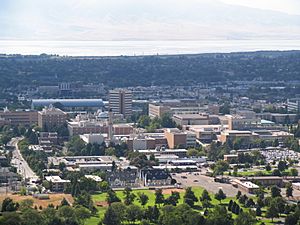
Higher Education (Colleges and Universities)
Brigham Young University (BYU) is a private university run by the LDS Church. It is one of the largest private universities in the United States, with over 34,000 students. The tallest building in Provo, the Spencer W. Kimball Tower, is on the BYU campus.
Rocky Mountain University of Health Professions is a private university that focuses on healthcare education. It offers programs in nursing, physical therapy, and other health sciences. This university will build Utah County's first new medical school.
Provo College is a private school that offers career training. It has programs in nursing, medical assisting, graphic design, and more.
Primary and Secondary Education (Schools)
Most of Provo is part of the Provo School District. The district has thirteen elementary schools, two middle schools, and three high schools. Provo High School was the first school in Utah County to be an IB World school. Timpview High School has won many state football championships.
Transportation
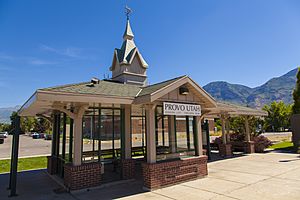
Interstate 15 goes through western Provo. This highway connects Provo to other cities in Utah. US-89 runs through the city as State Street. US-189 connects Provo to Orem and goes into Provo Canyon.
Amtrak, the national passenger train system, has a station in Provo. Its California Zephyr train stops here daily. Provo also has bus services from Salt Lake Express and the Utah Transit Authority (UTA). The UTA's commuter train, the FrontRunner, connects Provo to Salt Lake City.
The Provo Municipal Airport is Utah's second busiest airport. Allegiant Airlines has been based there since 2022.
Famous People from Provo
Many well-known people have lived in Provo. These include The Osmonds (like Donny and Marie), LDS Church leader Dallin H. Oaks, and NFL quarterback Steve Young. Goodwin Knight, who was the 35th Governor of California, was born in Provo. The global economist Dambisa Moyo also moved to Provo.
Sister Cities
Provo has three sister cities around the world:
Images for kids
See also
 In Spanish: Provo (Utah) para niños
In Spanish: Provo (Utah) para niños





